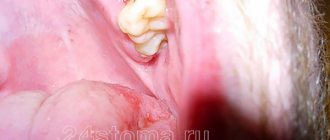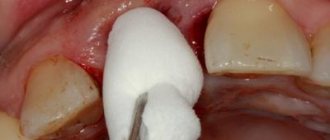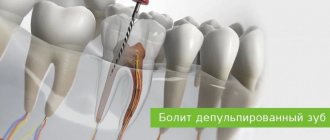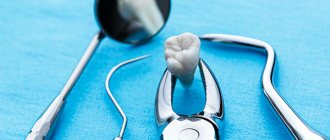The one-stage technique mainly includes one-stage implantation protocols with immediate loading, but in some situations, simultaneously with tooth extraction, a classic implant can also be installed using a two-stage technology. According to many clinical studies, it is one-stage implants installed in the socket of an extracted tooth that protect bone tissue from atrophy and can reduce treatment time with a guaranteed high long-term result of up to 96%1.
Indications
- teeth to be removed are rotten, mobile, destroyed by carious processes,
- single restorations,
- multiple restorations,
- tooth injury,
- simultaneous tooth extraction and implant installation.
Contraindications
- emergency tooth extraction when it is not possible to prepare for implantation,
- complex tooth extraction,
- general contraindications to implantation and surgery.
Dental drainage: what it is, what it looks like
What is tooth drainage? Translated from English, “drain” means “to drain.” This is a medical instrument or device, the main purpose of which is the continuous removal of liquid contents from inflamed tissues and cavities. Usually it is inserted into open wounds and left for a short time, thus, with its help, a procedure is carried out that promotes the outflow of pus, serous exudate, blood and ichor.
This device was first invented by a French surgeon. It was originally created from materials such as glass and rubber. Today, lighter, softer and smoother materials are used for manufacturing: rubber, silicone and latex - they do not get wet, are well fixed and hold, and do not cause significant discomfort.
If you want to know what dental drainage looks like, look at the photo below. This device looks like a small thin tube, and in some cases it even looks like a thin wire, tape or just a strip of material. The device has different sizes and diameters.
If you need to insert a tooth after it has been removed
The best solution to insert one tooth is a one-time implantation, but a tooth can only be inserted if too much time has not passed since its removal. To firmly fix the implant in the bone, the jaw bone tissue must be dense and have a certain height. But the longer a tooth is missing, the more the bone thins and dries out. Therefore, if you had a tooth removed several years ago, you can have it replaced either with prosthetics or classical implantation.
Indications for installing the system in the gums
Let’s take a closer look at who gets drainage and why. Many patients consult a doctor with an acute inflammatory process and severe swelling of the tissues of the oral cavity (and sometimes even the face), caused by advanced diseases and accompanied by the appearance of a lump or abscess on the gum.
In this case, it is simply necessary to resort to surgical measures, namely, to cut the inflamed gum, as well as the abscess, and release its contents. To prevent the wound from quickly overgrown again, and to prevent pathogenic contents from remaining and accumulating inside it again, specialists place a drainage on the tooth.
So, the main indication for installing the device: a purulent-inflammatory process in the mouth caused by pathologies such as advanced pulpitis and periodontitis, gumboil, fistula, abscess, cyst and granuloma. A wide opening of the purulent cavity and drainage of pathological foci are also carried out in such serious diseases as odontogenic osteomyelitis and phlegmon [1], when the bone structures of the jaw and soft tissues of the face are affected.
On a note! The procedure is contraindicated in patients with bleeding disorders and allergies to painkillers used during the operation and the incision on the gum.
Presence of contraindications
The main obstacle to dental bridge prosthetics mentioned above is the end defect. Another contraindication may be severe malocclusion.
Obstacles to implant installation:
- Significant deficiency of bone tissue (preliminary augmentation is required).
- Diseases of the cardiovascular and central nervous systems.
- Decompensated diabetes mellitus.
- Pathologies and dysfunction of the thyroid gland.
- Tuberculosis.
- Disruption of the chewing muscles.
Drainage of the hole after the root removal procedure
Separately, it is worth mentioning situations when drainage is installed and the socket of an extracted tooth is drained. The procedure is indicated in the following cases:
- immediately after removal of a neglected and irreparable unit that has caused the appearance of an abscess in the oral cavity: if the manipulation is not performed, the likelihood of developing postoperative complications increases,
- drainage in the gums after tooth extraction is a mandatory treatment measure for those patients who have developed purulent complications during the rehabilitation period: alveolitis, gumboil, abscess,
- drainage is often installed after the removal of a wisdom tooth, and this is done to directly administer medications into the wound, which ensures rapid tissue healing and, of course, minimizes complications.
Which is the best method to choose?
There is an alternative to dental prosthetics using implants, and for those who, due to contraindications or other reasons, cannot undergo implantation, this is a real salvation. And in each individual case, a method is selected based on specific conditions, the nature of the clinical picture, the requirements and capabilities of the patient.
But still, when choosing, it is necessary to take into account that implantation today is essentially the only method that provides complete restoration of the functionality of the dental system, including stopping bone atrophy. Perhaps a full-fledged alternative to dental implantation will appear in the near future, but for now it does not exist - all methods of prosthetics without implantation have disadvantages and do not ensure the transfer of chewing load to the bone, which causes degradation of the jawbone, gradual displacement and destruction of the remaining teeth.
Features of the procedure
Let's take a closer look at how drainage is placed on a tooth. The procedure includes several important steps.
Stage No. 1
First, the specialist conducts a thorough visual and x-ray examination of the inflamed area to get an accurate idea of the location of the abscess, its size and depth.
Stage No. 2
The doctor administers local anesthesia so that the patient does not experience pain during the procedure. Next, at this stage, surgical intervention is performed.
If the tooth next to which the abscess has appeared can still serve, then the specialist cuts the inflamed gum with a scalpel. In cases where saving the tooth is not practical, the dentist removes its root, after which he places a tube to drain the fluid directly into the open socket (in this case, no tissue incision is made).
Stage No. 3
The opened purulent cavity is thoroughly cleaned, treated with antiseptic solutions, after which drainage is fixed in it. One end of the device is inside the wound, and the other is outside.
Next, the doctor prescribes medications, antiseptic rinses and antibiotics for home use, which, together with the installed device, will work to quickly eliminate the inflammatory process and normalize the patient’s condition.
When is it necessary to remove a tooth along with the root?
All decent dentists try to preserve “their” patient’s tooth in every possible way. Even if we are talking only about the remaining root, today there are also several restoration options. One of the most popular is prosthetics using a stump tab.
However, in some cases complete extraction of the tooth is indicated, i.e. removal of both the coronal part and the root.
Indications for root removal:
- granulomas or cysts that do not respond to drug treatment;
- destruction or severe deformation of the root;
- inability to treat root canals (usually also due to deformation or non-standard shape);
- maxillary osteomyelitis;
- periodontitis or periodontal disease in a late advanced stage. In this case, the roots of the teeth have increased mobility and also act as a kind of “foundation” for tartar;
- cracks in the root or perforated bottom (such phenomena are contraindications for prosthetics using a stump inlay);
- “forgotten” fragments of dental instruments that cannot be removed;
Feelings after installation
Experts say that if the device is installed correctly, it should not cause any discomfort. Yes, its presence in the mouth can be felt by directly touching it with your finger or tongue. But the drainage in the tooth should not cause pronounced discomfort, rub the mucous membrane and get in the way. It is normal and correct if liquid is constantly released through it.
If you have a tooth removed and drainage installed, the sensations will, of course, be more pronounced. After all, you have undergone a full-fledged surgical operation, after which swelling, pain, a slight increase in body temperature, and difficulty opening your mouth are possible. However, all these symptoms are, to a large extent, just normal consequences of extraction (removal). But in some cases they can indicate serious complications. How to separate normality from pathology? The answer to this question is in the feature article on the site.
How to place a tooth if there is no root? Build a bridge!
If a tooth is missing, then you can choose bridge prosthetics. The prosthesis itself consists of several “glued” crowns, the number of which depends on the number of teeth that need to be restored. If one is missing, then the bridge will be three units. If we are talking about a double gap in the dentition, then a bridge of four units is used.
The process of installing a bridge on teeth
- dental impressions are taken
- the prosthesis itself is made
- installation process: grinding down adjacent teeth and fixing the prosthesis with dental cement.
The advantages of this solution are the relatively low price and low invasiveness of the procedure (compared to dental implantation). The disadvantages are the need to sharpen healthy teeth, the need for special hygiene, and the lack of load on the bone in the place of the missing tooth (as a result, the gum tissue under the “hanging” tooth will decrease over time).
Bridge prosthetics can be carried out both in case of a lack of chewing teeth and in the frontal zone.
You can read more about the method, technology and nuances in this article
Duration of treatment
Many patients are interested in how long tooth drainage costs. On average, it is left for 3-6 days. During this time, all pathogenic fluid should completely leave the wound. If all is well, the patient usually feels relief within 24 hours after installation. With each subsequent day, positive dynamics are observed, swelling subsides and disappears, and the color of the mucous membrane normalizes.
It also happens that after this period, unpleasant symptoms of the disease persist, which means that the inflammatory process continues. Then doctors conduct a new examination, adjust treatment tactics and resort to other measures.
If there is drainage after tooth extraction, when can it be pulled out? The doctor decides. If the dynamics are positive, the tube is removed after 3-4 days. When the inflammatory process persists or complications of extraction appear (for example, alveolitis), the specialist pulls out the tube, performs a thorough curettage, that is, cleaning the hole, after which he can reinsert the device.
How much does it cost to get teeth inserted?
Teeth can be inserted in different ways and using different crowns or dentures, so the price of the service can be very different. Below we publish prices for services for restoring damaged or lost teeth, which are offered by our dental clinic in Moscow - “Aesthetica”!
If you want to insert teeth so that the restoration result is both beautiful and high-quality, come to our dentistry! We have created all the conditions for high-quality, painless dental restoration in the most difficult cases!
Rules to follow when having a device in your mouth
Anyone who has had drainage installed after a gum incision or tooth extraction needs to know how to behave during this period. Doctors give the following recommendations:
- you need to follow a certain diet: it is forbidden to eat hot and hard foods and chew on the side of the jaw where the intervention was performed. You need to give preference to soft and liquid dishes, drink more clean water,
- It is undesirable to sleep on the cheek on which the device is installed,
- Brushing your teeth should be done extremely carefully, avoiding the area where the tube is located: for hygiene, you can use a brush with soft bristles and a non-abrasive toothpaste. It is better to avoid using an irrigator for a while,
- Intensive rinsing of the mouth is prohibited: to carry out antiseptic and disinfectant procedures, simply take liquid into your mouth, hold for 2-3 minutes, spit it out,
- It is important to protect yourself from physical activity and sports.
What options for dental prosthetics exist besides implants?
The integrity of the dentition can be restored in various ways - mainly by installing dentures, removable or fixed. Today, there are many options for prosthetics based on a variety of materials and designs. Let's look at some analogues of dental implantation.
Removable prosthetic structures
Removable dentures are popular because... They allow you to replace all missing teeth (full dentures) or several (partial dentures). In addition, they are relatively inexpensive, have good aesthetics, do not require surgery for installation, have a minimum of contraindications and are quite easy to replace.
Lamellar dentures
They can be either full or partial. Made from acrylic and other polymer materials. These dentures are solid. They are fixed either by “suction” to the gums (full dentures), or by fixing them to adjacent teeth using special clasps (partial dentures). The advantages of such prostheses include affordable prices, the possibility of easy replacement and repair. The disadvantages are the difficulty of getting used to, not very reliable fixation (especially for complete dentures), chafing, injury to the gums, inability to chew solid food, short service life - from 2 to 7 years.
Flexible prostheses
They can also be complete or partial. They are made from nylon and other softer materials (Acry-free). Therefore, the advantages include smaller sizes (compared to plate ones), greater elasticity, faster adaptation, less chafing and injury to the gums. Disadvantages - they are often deformed (due to stretching of the base), chewing hard food causes pain. Service life is from 3 to 8 years.
Clasp dentures
These dentures are suitable for replacing only a few missing teeth. They must be fixed to the supporting teeth using special locks, hooks or telescopic crowns. Their key feature is a metal arc that connects all elements and evenly distributes the chewing load. Currently, biotechnological clasp dentures (without the use of metal) are also used. The service life is considerable - 7-10 years. But at the same time, such a prosthesis requires support on healthy teeth, which experience increased stress and often collapse faster because of this.
Common disadvantages of removable dentures are:
- violation of diction,
- insufficiently reliable fixation,
- dietary restrictions,
- special hygiene requirements,
- atrophy of bone tissue at the site of lost teeth,
- the need for periodic replacement.
Nevertheless, removable dentures are a good alternative to dental implantation due to their low cost, fairly quick adaptation, the possibility of self-removal and installation (for some models), and the absence of the need for serious intervention (gum incisions, etc.) during installation.
Bridges
Fixed dentures are used to restore several missing teeth in a row (1-4). A bridge is a solid structure of several crowns installed on the outer teeth. The main advantages of this alternative to dental implantation are excellent aesthetics, structural strength, resistance to stress, and perfect diction. But alas, not everything is so good, there is a fly in the ointment:
- bridges are not suitable for complete edentia (lack of teeth) and terminal defects due to the absence of supporting teeth,
- the need to grind abutment teeth for crowns,
- A bridge does not stop bone atrophy.
Otherwise, this is a great way to restore a charming smile with the help of beautiful and durable zirconium or ceramic crowns, which will also cost less than implantation.
Combined prosthetics
By combined prosthetics it is more correct to understand complex designs of prostheses in which the removable part is installed on a non-removable base. Remaining healthy teeth are used to secure fixed elements. The removable part of the prosthesis is attached to them with clasps, telescopic crowns or attachments. It is a rather complex alternative to dental implantation. Its advantages and disadvantages are similar to those for fixed prosthetics.
Mini implantation
Often this method of prosthetics is used in cases of complete absence of teeth. For reliable fixation of the prosthesis, mini-implants are used - up to 2.5 mm in diameter, shallowly immersed in the bone. They have tops in the form of spherical abutments, to which the base of the prosthesis is attached. Mini-implants are cheaper than full-size models and take root easier and faster.
But firstly, this is still implantation, so for those who have absolute contraindications, this method is not suitable.
And secondly, their fixation and strength are lower than those of conventional implants, so they are used with serious nutritional restrictions in order to reduce the load on the locking mechanisms and the implant body.
Orthodontic treatment
In some cases, it is possible to move existing teeth to correct the defect. But this option is only possible if the bone tissue is in good condition and after a thorough diagnosis. Unfortunately, the method is not omnipotent; it has contraindications, requires long-term wearing of braces and does not guarantee an ideal result.
What to do if the device falls out
Some patients do not even have time to find out how the tooth drainage is removed at the dentist, because the tube itself falls out of their mouth. What to do in this situation? If the system falls out in the first few days after the procedure, then you need to quickly contact your doctor to have it reinstalled. During this period, the likelihood that all the pus has come out is still too small, and the wound will heal very quickly, accordingly, pathogens will remain inside it.
If the device falls out 4-5 days after the procedure, and you notice that the swelling has subsided and pus is no longer oozing from the wound, then there is nothing to worry about. In this case, we can assume that the drainage installed for the treatment of various dental pathologies and after tooth extraction has successfully fulfilled its purpose. However, you still need to see a doctor.
Important! The main reasons for premature loss of the device: improper oral hygiene technique, active rinsing, violation of the postoperative regimen, poor-quality installation of the tube in the dental office.
Expert opinion
Elena Vladimirovna Orlova
Specializations: Dentist-therapist, endodontist
Experience: 33+
“Under no circumstances should you install drainage on a tooth yourself. You can injure the tissues or, even worse, introduce an infection into them, after which the inflammation will flare up with renewed vigor. All procedures for its installation and removal must be carried out by professional doctors under completely sterile conditions."
Crown instead of an extracted tooth - implantation
Implantation is a modern solution for partial and complete adentia. This is what doctors recommend to patients, and there are many reasons for this:
- complete replacement of a lost tooth - not only the upper part, but also the root system;
- restoration of chewing and other functions - after prosthetics, the patient is not limited in the choice of menu, and the quality of speech does not suffer;
- aesthetics - both the crown itself and the artificial gum contour, if present, look natural;
- preservation of bone tissue - bones experience full load, which eliminates atrophy and degradation of bone structures;
- speed of prosthetics - some protocols allow you to restore a tooth immediately after removal.
Implantation options:
- Classic two-step protocol. After removal, the doctor waits for complete healing of the gums and restoration of soft and bone tissues. Then he installs the implant and, after its complete engraftment (4-6 months), places an artificial crown or bridge on the implants without damaging neighboring units. The treatment is long and is recommended for patients who, immediately after extraction, were unable to replace their teeth with prosthetics - the socket has healed, and the tissues have partially atrophied. It is possible to speed up treatment using a two-stage protocol. Premium dental implants Nobel, Strauman take root in 2-4 months, which reduces the period of prosthetics by half.
- One-stage implantation protocol. When a tooth is removed, the patient is immediately implanted with an implant, a gum former or a full-fledged temporary crown. Such treatment requires removal by an experienced implant surgeon, as well as preliminary examination to reduce risks.
- One-stage implantation protocol. It completely eliminates the question of when a tooth can be replaced with a prosthetic after extraction, as it combines all three stages of treatment. The doctor performs an extraction, places a dental implant and immediately loads it with a crown. The patient simply replaces the damaged tooth with a new artificial one, which significantly speeds up the recovery process.
Self-removal of the structure: possible or not
Some patients experience severe discomfort, so they are interested in how to remove drainage from a tooth on their own. Others do not have time to make an appointment with a doctor on time, so they also want to know the answer to this question. Often, the dentists themselves provide detailed instructions so that the patient can perform the procedure at home. The procedure should be as follows:
- wash thoroughly with soap and disinfect your hands,
- treat the oral cavity with some antiseptic: Miramistin, Chlorhexidine are suitable,
- stand in front of the mirror, open your mouth, carefully grab the tip of the tube protruding from the wound with your thumb and forefinger and pull it towards you without force,
- rinse your mouth with an antiseptic,
- Do not consume food or drink for the next 2 hours.
“On the eve of the New Year holidays, I had a drainage installed after the removal of a dental cyst. The procedure is painless, as it is under anesthesia, but the doctor said that due to the holidays, I will have to pull the tube out of the wound myself in four days. I described in detail how this is done. When the hour struck, I was very worried, I thought it was difficult, but in fact I did everything quickly. However, after ten minutes the pain was so severe that I had to take pills. But within a day I even forgot that I once had this tube. After the holidays, I saw the doctor, he said that I was good, and the tissues were healing normally!”
Irina R, review from 32top.ru
The procedure is simple, but if the device has not fulfilled its main purpose, then it should not be carried out under any circumstances. And, in general, even if your condition has improved significantly, you should not resort to independent measures without consultation with a specialist. It is better to have a professional doctor perform all steps to remove the device. Why? Removing the tube yourself can cause severe pain, prolonged bleeding, damage blood vessels and injure surrounding tissue.
Veneers and Lumineers
Veneers and lumineers can be used as aesthetic options for dentures on the front teeth. Veneers are very thin shells of porcelain that are given a color similar to the natural color of the patient's teeth. Veneers completely match the shape of a natural tooth. Such plates are attached to the front surface of the tooth.
Lumineers are transparent and very thin plates about 0.15 mm thick. Placed on the front surface of the tooth. This cosmetic procedure is non-invasive, quick, painless and long lasting.
These qualities determine the indications for the installation of veneers or lumineers:
- Crack and small chip of a tooth;
- Yellowing or darkening of tooth enamel;
- Uneven frontal surface;
- Crooked teeth.
Installation of prosthetic anterior teeth on the upper and lower jaws
The use of dentures for the lower and upper anterior teeth is almost the same from a practical point of view. The difference may lie in the fact that the installation of dentures for the upper teeth requires more attention from the dentist, since the upper jaw is somewhat less well supplied with blood than the lower jaw, hence healing here will take a little longer. And also, when a person smiles, the front teeth are the first to be seen from above, so it is necessary to pay more attention to the aesthetic side of prosthetics.
What is a wisdom tooth
In everyday life, wisdom teeth are the third molars, or the last, eighth teeth in a row, that is, “eights.”
The upper third molars can vary in shape and size, and are usually smaller than other molars and lower 8s. They have two or three roots, which sometimes grow together into one. But they always have three channels.
The lower wisdom teeth can also vary in shape and size, but, as a rule, they are larger than the upper “eights”. The roots of these teeth are short, sometimes fused, and often have a curved shape.










